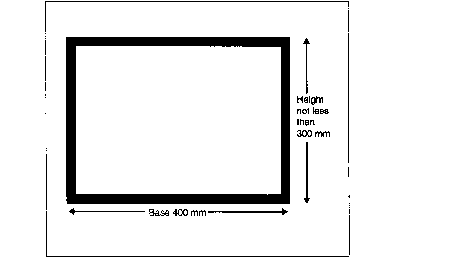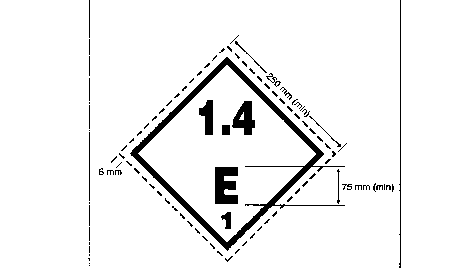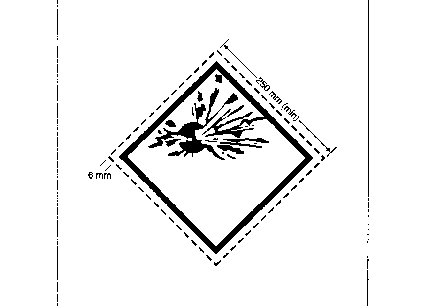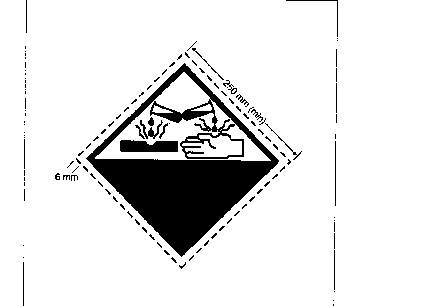- Latest available (Revised)
- Original (As made)
The Carriage of Explosives by Road Regulations 1996
You are here:
- UK Statutory Instruments
- 1996 No. 2093
- SCHEDULE 5
More Resources
Status:
This is the original version (as it was originally made). This item of legislation is currently only available in its original format.
Regulation 15
SCHEDULE 5INFORMATION TO BE DISPLAYED ON VEHICLES AND CONTAINERS
PART IREQUIREMENTS
1. At all times when explosives are being carried in a vehicle—
(a)two blank rectangular orange-coloured panels conforming to the requirements of paragraph 4 or 5 shall be affixed to the vehicle, one at the front and the other at the rear;
(b)three of each of any danger sign and subsidiary hazard sign required to be displayed under this Schedule shall be affixed to the vehicle, one of each to each side, and one of each to the rear of the vehicle; and
(c)where the explosives are carried in a container, one of each of any danger sign and subsidiary hazard sign required to be displayed under this Schedule shall be affixed to the container.
2. Where explosives are being carried in a container in or on a vehicle, it shall be sufficient compliance with paragraph 1(b) if any danger sign or subsidiary hazard sign which is required to be affixed to the vehicle under that sub-paragraph is affixed to the container, provided any such sign is visible from the outside of the vehicle, and positioned as if it had been affixed to the vehicle in accordance with that sub-paragraph.
3. Nothing in this Schedule shall require a danger sign or subsidiary hazard sign of the same specification to be displayed more than once at the rear or on either side of a vehicle.
4. Each panel referred to in paragraph 1(a) shall—
(a)be in the form of the following diagram and comply with the measurements in the diagram; and
(b)have a black border not more than 15 millimetres wide.
5. Where the size and construction of the vehicle is such that the available surface area is insufficient to affix a panel of the measurements specified in paragraph 4, that paragraph shall apply as if the specified measurements for the base were 300 millimetres, for the height, 120 millimetres and for the border, 10 millimetres.
6. Each danger sign and subsidiary hazard sign required to be displayed under this Schedule shall—
(a)be in the form of a square set with its side at an angle of 45° to the vertical; and
(b)have an orange-coloured background with a black border and any figure, letter or pictograph required by the provisions of this Schedule shall be in black.
7. Each orange-coloured panel, danger sign and subsidiary hazard sign required to be affixed to or displayed under this Schedule shall—
(a)be clearly visible; and
(b)so far as is reasonably practicable, be kept clean and free from obstruction at all times when explosives are being carried.
8. Any orange-coloured panel, danger or subsidiary hazard sign, other than one which is displayed under the Carriage of Dangerous Goods Regulations 1996 which does not relate to the explosives being carried, or any residue thereof—
(a)shall be covered or removed; and
(b)in the case where an orange-coloured panel is covered, any material used to cover it shall remain effective after 15 minutes engulfment in fire.
9. Where explosives in Division 1.1, 1.2 or 1.3 are carried in a vehicle or container, there shall be displayed in accordance with paragraph 1, danger signs which—
(a)are in the form of the following diagram (the Division number “1.2” and the Compatibility Group letter “E” are only examples);
(b)comply with the measurements in the diagram except that larger measurements may be used in which case the measurements shall be increased proportionally;
(c)have a pictograph of a bomb blast filling most of the upper half;
(d)have the Division number and Compatibility Group letter appropriate to the explosives being carried written in the lower half; and
(e)have the class number “1” written in the bottom corner below the Division number and Compatibility Group letter.
10. Where explosives in Division 1.4, 1.5 or 1.6 are carried in a vehicle or container, there shall be displayed, in accordance with paragraph 1, danger signs which—
(a)are in the form of the following diagram (the Division number “1.4” and the Compatibility Group letter “E” are only examples);
(b)comply with the measurements in the diagram except that larger measurements may be used in which case the measurements shall be increased proportionally;
(c)have the Division number appropriate to the explosives being carried written on the upper half;
(d)have the Compatibility Group letter appropriate to the explosives being carried written on the lower half; and
(e)have the class number “1” written in the bottom corner below the Compatibility Group letter.
11. In the case of explosives which are carried in a vehicle or container solely in connection with an application for their classification, there shall be displayed, in accordance with paragraph 1, danger signs which—
(a)are in the form of the following diagram; and
(b)comply with the measurements in the diagram, except that larger measurements may be used in which case the measurements shall be increased proportionally.
12. Where explosives allocated on classification the UN Number 0018, 0019, 0020, 0021, 0076, 0077, 0143, 0224 or 0301 are carried in a vehicle or container, there shall be displayed, in accordance with paragraph 1, subsidiary hazard signs which—
(a)are in the form of the following diagram; and
(b)comply with the measurements in the diagram except that larger measurements may be used in which case the measurements shall be increased proportionally.
13. Where explosives allocated on classification the UN Number 0015, 0016, 0018, 0019, 0301 or 0303 are carried in a vehicle or container, there shall be displayed in accordance with paragraph 1, subsidiary hazard signs which—
(a)are in the form of the following diagram; and
(b)comply with the measurements in the diagram except that larger measurements may be used in which case the measurements shall be increased proportionally.
14. In the case of a vehicle or container carrying explosives of different Compatibility Groups, no Compatibility Group letter shall be written on any danger or subsidiary hazard sign required to be displayed under this Schedule.
PART IIEXCEPTIONS
15. Paragraphs 1 to 7 and 9 to 14 shall not apply where—
(a)the explosives carried are explosive substances in Compatibility Group G not exceeding 1 kilogram in quantity;
(b)the explosives carried are in Compatibility Group B or unclassified explosives not exceeding (in either case) 10 kilograms in quantity;
(c)the explosives carried are—
(i)explosives of a type marked with an asterisk in Part II of Schedule 1, or
(ii)smokeless powder in Division 1.3 (being the explosive substance allocated on classification the UN Number 0161),
and the total quantity of all explosives carried in the vehicle does not exceed 100 kilograms;
(d)the explosives carried are—
(i)in Division 1.4 and in a quantity not exceeding 500 kilograms, except in the case of explosives in Compatibility Group S in which case no upper limit applies, and
(ii)of a type other than any of those specified in any of the sub-paragraphs above;
(e)the explosives carried are in a quantity not exceeding 50 kilograms and are of a type other than any of those specified in any of the sub-paragraphs above.
16. Paragraphs 1 to 7 and 9 to 14 shall not apply where the only explosives in the vehicle consist of, one or more of the following—
(a)blasting explosives not exceeding 50 kilograms in quantity;
(b)detonating cord not exceeding 10 kilograms in quantity;
(c)detonators not exceeding 100 grams in quantity or 100 in number.
17. Paragraph 8(a) shall not apply to any danger or subsidiary hazard sign displayed on a vehicle or container in circumstances where some of the explosives in respect of which the signs were displayed have been unloaded and the only remaining explosives being carried are of any of the types and quantities specified in the sub-paragraphs of paragraphs 15 or 16.
18. While the vehicle is being loaded or unloaded—
(a)paragraph 1(b) and (c) shall not apply;
(b)paragraph 7 shall not apply to the orange-coloured panel at the rear of the vehicle.
19. Paragraph 1(a) shall not apply in relation to any trailer which is being used for the carriage of explosives where that trailer is detached from the motor vehicle.
Options/Help
Print Options
PrintThe Whole Instrument
PrintThis Schedule only
Legislation is available in different versions:
Latest Available (revised):The latest available updated version of the legislation incorporating changes made by subsequent legislation and applied by our editorial team. Changes we have not yet applied to the text, can be found in the ‘Changes to Legislation’ area.
Original (As Enacted or Made): The original version of the legislation as it stood when it was enacted or made. No changes have been applied to the text.
More Resources
Access essential accompanying documents and information for this legislation item from this tab. Dependent on the legislation item being viewed this may include:
- the original print PDF of the as enacted version that was used for the print copy
- lists of changes made by and/or affecting this legislation item
- confers power and blanket amendment details
- all formats of all associated documents
- correction slips
- links to related legislation and further information resources






